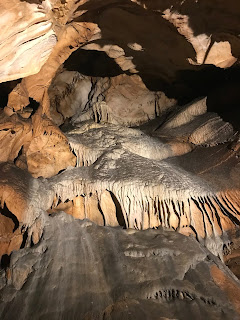Plitvice Lakes National Park
Plitvice Lakes National Park:
Plitvice Lakes National Park is one of the oldest and largest national parks in Croatia. The lake park contains 16 cascading lakes that are made from rivers. The park has an upper part and a lower part. Naturally, the water flows from the upper part to the lower part over rocks, forming countless waterfalls (a staple for this park). The lake is also famous for it's distinct color which changes depending on the amounts of minerals and organisms in the water as well as the angle of the sunlight. Typically, the waters have a green or turquoise color.
One of my favorite waterfalls with the green/blue water
I was staying in Zagreb and I booked a tour that would take me from Zagreb to the Park. I had a tour with my friend and another girl from France. It was so nice how private the tour was. My tour guide was fantastic as well. On the way to the park, he explained some history of Zagreb and Croatia and introduced us to the park. We also stopped in a village called Rastoke. This village only has 65 inhabitants and has many beautiful waterfalls. We then arrived at the park and took a five hour walking tour of the park. The park is stunningly beautiful and I thoroughly enjoyed my time there.
Rastoke
Why was Plitvice Lakes National Park put on the UNESCO Natural World Heritage List?
Plitvice Lakes National Park was added to the UNESCO Natural World Heritage List in 1979. The park meets two of the natural criteria: "to be outstanding examples representing significant on-going ecological and biological processes in the evolution and development of terrestrial, fresh water, coastal and marine ecosystems and communities of plants and animals" and "to be outstanding examples representing major stages of earth's history, including the record of life, significant on-going geological processes in the development of landforms, or significant geomorphic or physiographic features."
The largest Waterfall in the park
What is being done to preserve this Lake Park?
Plitvice Lakes National Park is preserved by several local and country organizations as well as natural non-profit organizations. The park also receives support from UNESCO. However, there have been problems with this. My tour guide informed me that UNESCO has threatened to remove Plitvice Lakes National Park as a UNESCO Natural World Heritage site because of their lack of care for the natural state of the park. As was told to me, the police/rangers do little to enforce rules and regulations in the park. If they do enforce a rule/regulations, it is common that bribery will be used to get out of a punishment. I gathered that there is much corruption in the Croatian government. That corruption trickles down to corruption in enforcing rules/regulations. This is quite sad. Overall, the political unrest in Croatia can be to blame for the parks degradation.
Are there issues with overpopulation, pollution, natural hazards,and or tourism?
As usual, over population is not an issue. No one lives in the park.
I asked my tour guide about any natural hazards are impacting the lake park. He could not really think of any. One thing that he did point out to us along the tour was a lake that was completely dried out. The park claims that this is due to less rainfall but my tour guide thinks otherwise. He believes that pollution has something to do with it and that eventually, other parts of the lakes will also dry out.
The dry lake
Pollution does not seem to be too big of an issue. Although the lakes are much dirtier than they were twenty years ago. My tour guide said that you could fill your water bottle up in the lake and drink the water twenty or thirty years ago. Today, the water is not as clean to be able to do that. I will talk about the magnitude of tourism in the next paragraph, but to put it shortly, there are immense amounts of tourists everyday. I was surprised that I did not see one piece of trash in the grass or in the water. I did not even see anyone trying to swim in the lakes or go off the paths where it was not allowed. There was no evident pollution, such as trash, that I could see. However, there is always other kinds of pollution such as waste run off in the rivers that flow into the lakes. There are several species of fish in these lakes. If pollution like this continues, these fish will die off.
Over-tourism is a huge issue with this park. Over one million tourists visit this park every year. This number will continue to increase. My tour guide estimated that the park will reach 1.5 million tourists this year. On the day that I went to the park, the weather was a bit cold so I thought that there would not be too many people. I was wrong. Apparently, people will come to this park, rain or shine, cold or warm. My tour guide said that the entrance ticket price raises every year. He still thinks people would come even if they raised the price to $100 for a ticket. It is the most visited attraction in Croatia. I definitely think that they need to put a limit on how many tourists can enter the park on a daily basis. There were points during my tour that we had to wait in line to see a waterfall.
* Information gathered from the tour, the visitor's center, and the UNESCO website











Comments
Post a Comment